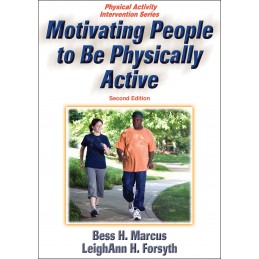- Reduced price

Order to parcel locker

easy pay


 Delivery policy
Delivery policy
Choose Paczkomat Inpost, Orlen Paczka, DHL, DPD or Poczta Polska. Click for more details
 Security policy
Security policy
Pay with a quick bank transfer, payment card or cash on delivery. Click for more details
 Return policy
Return policy
If you are a consumer, you can return the goods within 14 days. Click for more details
Motivating People to Be Physically Active, Second Edition, translates research, theories, and concepts of behavioral science into a useful handbook for health professionals involved in the planning, development, implementation, or evaluation of physical activity promotion programs. The book describes proven methods for helping people overcome sedentary behavior and make physical activity a regular part of their lives.
Based on the five-stage model of motivational readiness for change, this comprehensive reference will help you design intervention programs for individuals and groups in both worksite and community settings. This behavior change method can be used with healthy adults as well as those with chronic physical or psychological conditions. Youll also learn to measure and improve clients motivation and assess their physical activity patterns and barriers.
The second edition has been fully updated and expanded to include these features::
-An updated chapter that discusses and compares the recent physical activity recommendations of the Centers for Disease Control and Prevention, the American College of Sports Medicine, and the Institute of Medicine and presents the pros and cons of the recommendations for key populations
-An expanded description of the benefits of a physically active lifestyle
-Information on how technology, including accelerometers, and Web-based intervention strategies can be used in changing physical activity behavior
Motivating People to Be Physically Active, Second Edition, contains many practical tools and ideas to assist you in program implementation. Youll find reproducible questionnaires, worksheets, logs, and more to assist clients in their transition to active living. The book includes case studies of successful community and worksite programs that can serve as a starting point for your own interventions and stage-specific strategies and recommendations for including and motivating all participants. The authors also provide a list of suggested readings that you can use to enhance your programs. Web addresses and phone numbers of physical activity organizations are included, which can provide you with additional information and resources.
With its focus on psychological and behavioral research and accessible reading style, Motivating People to Be Physically Active, Second Edition, is the essential resource for physical activity behavior modification. In addition to allowing you to design effective intervention programs, its many program ideas, tips, and tools spark your motivation to educate and encourage others to lead a more active and healthier lifestyle.
Motivating People to Be Physically Active, Second Edition, is part of the Physical Activity Intervention Series (PAIS). This timely series provides useful educational resources for professionals interested in promoting and implementing physical activity programs to a diverse and often resistant population.
Data sheet
Contents
Physical Activity Intervention Series Preface
Preface
Acknowledgments
Part I Theoretical Background and Tools for Measuring Motivational Readiness
Chapter 1 Describing Physical Activity Interventions
Physical Activity Recommendations
Definitions of Physical Activity, Exercise, and Physical Fitness
Physical Activity Interventions
Theoretical Models
Motivational Readiness for Behavior Change
Conclusion
Chapter 2 The Stages of Motivational Readiness for Change Model
Motivational Readiness and the Stages of Change
Match Treatment Strategies to Stages of Change
Processes of Behavior Change
Conclusion
Chapter 3 Integrating Other Psychological Theories and Models
Learning Theory
Decision-Making Theory
Behavioral Choice Theory
Social Cognitive Theory
Ecological Model
Relapse Prevention Model
Conclusion
Chapter 4 Putting Theories to Work By Looking at Mediators of Change
Consider Mediators of Physical Activity Behavior Change
Factors That Enhance Physical Activity
Unlock the “Black Box”
Conclusion
Chapter 5 Using the Stages Model for Successful Physical Activity Interventions
Imagine Action: A Community-Based Program
Jump Start to Health: A Workplace-Based Study
Jump Start: A Community-Based Study
Project Active: A Community-Based Study
Project STRIDE: A Community-Based Study
Step Into Motion: A Community-Based Study
Conclusion
Part II Applications
Chapter 6 Assessing Physical Activity Patterns and Physical Fitness
Discovering Patterns of Physical Activity Behavior
Determining Intensity Level
Tracking Physical Activity Behavior
Assessing Fitness
Assessing Physical Activity and Fitness in Group Settings
Conclusion
Chapter 7 Using the Stages Model in Individual Counseling
Physical Readiness
Physical Activity History
Psychological Readiness
Confidence
Set Short- and Long-Term Goals
Measure Success
Conclusion
Chapter 8 Using the Stages Model in Group Counseling Programs
Leading a Stage-Based Group
Learning From a Sample Stage-Based Curriculum
Assessing Your Effectiveness as a Leader
Conclusion
Chapter 9 Using the Stages Model in Work Site Programs
Building Support for Your Program
Assessing Motivational Readiness
Choosing Your Target Audience
Reaching Your Target Audience
Developing Stage-Matched Materials
Focusing on Moderate-Intensity Activity
Planning Events
Adding Incentives for Participation
Conclusion
Chapter 10 Using the Stages Model in Community Programs
Assessing the Communitys Readiness for Change
Reaching Individuals Within a Community
Developing Stage-Matched Messages
Using a Media-Based Approach to Reach Your Target Audience
Working With Community Leaders to Reach Your Target Audience
Conclusion
Appendix A: Questionnaires
Appendix B: Additional Resources
References
Index
About the Authors
